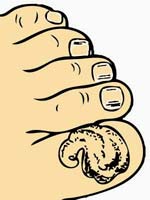Onychogryphosis or ram’s horn nails is a hypertrophy which sometimes create nails similar to claws or a ram’s horn, possibly as a result of damage or peripheral vascular problems, but most frequently supplementary to disregard and failure to trim the nails for prolonged intervals. It is most frequently present in the older or infirm people.
Among the different reasons behind this problem, neglect by specialist nursing services is an element that should be taken into consideration. Onychogryphosis can happen occasionally as a congenital condition.
The indicators of onychogryphosis include things like thickening, curving, yellowing, and dirty particles beneath the finger nail or toe nail. The curve of the finger nail or toe nail affected by onychogryphosis can occur at the free border, bending around the finger, or perhaps it could begin under, the cuticle of the nail, making the finger nail or toe nail to extend to the left or right at an extreme angle.
The angle and level of curvature of the finger nail or toe nail is dependent upon whether the from the side or sides or central part expands more quickly. Onychogryphosis is much more typical in toenails compared to fingernails, so when it does show up on the fingernails, it usually impacts just one nail.
Onychogryphosis is usually a result of damage or recurring micro damage to the nail or nail matrix, in toenails, this could be a result of some thing as usual as inappropriate shoes or excessive trimming of the nail plate, just one isolated damage, genetic skin disorder, skin cells to grow too quickly, syphilis, pemphigus vulgaris, fungal contamination, deterioration of the blood vessels and neuronal system, along with personal neglect or the lack of ability to trim fingernail or toenails because of not being able to move around and deteriorating vision problems, particularly in elderly people. In unlikely occasions, injury to the ulnar nerve system and peripheral nervous system is the primary trigger.
It is probable for the thickened finger nail or toe nail to tear the nail bed. Once the nail bed is injured, ulcerations or sore areas can form, producing surroundings where bacterial infection could grow. Particularly in people with lack of feeling in their legs. This multiplies the complications and increases the risk to the patient.
The discomfort and tension of onychogryphosis can be comparable to a fungal contamination of the fingernail or toenails. Sometimes there is no method to make a distinction between a fungal contamination and onychogryphosis without getting a culture. For this reason, it’s most useful for a patient to seek advice from a doctor to establish the absence or existence of fungus infection. As soon as it is established that absolutely no fungal infection is present, a patient has a couple of choices regarding how to move forward.
The starting point would be to get rid of tension on the finger nail or toe nail. Aside from staying away from tension and injury to the nails, the best method to handle the nails would be to have them trim shortly. Additionally, skincare lotions consisting of urea are occasionally given to take away the thickness of the finger nail or toe nail and to dissolve the tissue mass around the nail. Therapy for the problem is determined by the source. For instance, direct damage to one nail or matrix could be irreversible, and affected individuals may choose to have the nail completely extracted.
On the other hand, if the problem is a result of recurring micro damage, for example from footwear, in that case staying away from the tension can occasionally improve the disease. Onychogryphosis is not often remedied, but more usually it is managed. Traditional techniques are recommended in the older people, especially in situations with vascular deterioration or hyperglycemia because of diabetic issues. For most of these situations, the repeated usage of electric powered drills, and medical pincers are going to help to create and sustain a shrinkage of nail plate depth and size.
In case a patient chooses to have the nail extracted, surgeons are going to surgically take out the finger nail or toe nail at the root, and after that chemically get rid of the matrix, therefore the finger nail or toe nail won’t grow again. Irreversible extraction of the nail plate can be accomplished by skin based application of phenol, in which elimination of the matrix can be carried out with a ten %percent solution of caustic soda. Losing the nail could be humiliating initially, however the cured site could be more visually pleasing, significantly less uncomfortable, and much less likely to become contaminated.
Since it is more likely to be managed than to be remedied, the problem has to be considered irreversible. Artificial nails must not be viewed as an option for the issue. Artificial nails are going to put unwanted weight to the finger nail or toe nail. When the nail expands, that excess weight will increase tension to the matrix, which happens to be already injured. Additionally, in case any kind of injury is present to the adjoining tissue or possibly the nail bed, artificial nail might not hold on properly. This opens the probability of water or particles becoming accumulated, which raises the chance of fungus infection.
You may also like:
- Koilonychia or Spoon Shaped Nails Causes and Spoon Nails Treatment
Koilonychia or spoon shaped nails describes nails turning into concave form. Spoon nails can be treated based on koilonychia causes.
- 15 Brittle Nails Home Remedies and Onychorrhexis Treatments
Brittle nails or onychorrhexis caused by various factors can be successfully treated and cured with home remedies. Learn how!!!
- Toenail Falling off Causes and Onychoptosis Home Treatment
Onychoptosis home treatment for falling off toenails include: removing the toenail, maintaining the region dry to stop bacterial infection and waiting.



